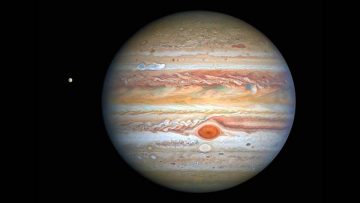 From Vulcan to Krypton, Alderaan to Gallifrey, alien worlds have been a fixture of science fiction for decades. Science fiction became science fact in 1995 when a team of astronomers revealed the presence of a planet orbiting a star other than the sun – the first extrasolar planet, or exoplanet, to be discovered.
From Vulcan to Krypton, Alderaan to Gallifrey, alien worlds have been a fixture of science fiction for decades. Science fiction became science fact in 1995 when a team of astronomers revealed the presence of a planet orbiting a star other than the sun – the first extrasolar planet, or exoplanet, to be discovered.
Since then, the exoplanetary population has sky-rocketed to more than seven hundred. A big factor behind this boom was the 2009 launch of Kepler, NASA’s dedicated planet hunting telescope. It was named after Johannes Kepler, the seventeenth century astronomer who first worked out the mathematics behind how planets orbit stars. Exoplanets can also be found from the ground and facilities such as the UK’s WASP and SuperWASP telescopes, based in South Africa, have gleaned a significant bounty.
Both the WASP and Kepler telescopes use the ‘transit method’ to detect exoplanets, the latter’s gaze fixed on 150,000 stars in one particular patch of the night sky. If a planet exists around a star it will dip in brightness every time that planet passes – or transits – in front of it. These dips in brightness are tiny: if a far off alien civilisation were looking at the Earth transiting the Sun, they would only see our star dim by about 0.01%.
Yet from this tiny variation in the light from a distant star, not only can astronomers detect the presence of a planet, they can also use mathematics to tease out the planet’s properties. The holy grail for planet-hunters is finding a second Earth – a planet that has a similar mass, radius, distance from its sun and surface temperature to our home planet. If complex life was able to develop on our own world, perhaps it could have also gotten a foothold on an exoplanetary doppelganger.
The period of the planet, or how long it takes the world to orbit its star, is found by counting the amount of time between dips in brightness – every time the star dims, the planet has completed one more revolution. Next up is the radius of the planet. Astronomers infer this by how much the star dims – the bigger the planet, the more light is blocked. Jupiter would block 1 % of the Sun’s light compared to the Earth’s 0.01%.
The distance of the planet from the star can also be added to the list using a mathematical equation, first formulated by Kepler, which describes how the distance is related to the planet’s orbital period. The only extra information needed is the mass of the star itself which can be derived from how bright the star is – the brighter the star, the more massive it is.
Then things get a bit more difficult, and back up observations are needed from telescopes employing a different method. Dimming of starlight is not the only effect an orbiting planet has on its host: it also exerts a gravitational tug on it. This small force causes the star to wobble very slightly and the bigger the wobble, the more massive the planet. Astronomers use mathematics to relate the speed at which the star wobbles to the planet’s mass. This is not just a double check: astronomers also discover exoplanets this way.
Armed with that mass, and the planet’s radius, astronomers are able to calculate the exoplanet’s density – which is simply the mass divided by the volume (which you can calculate from the radius). The density is an important factor in working out whether the exoplanet is truly Earth-like. The planet could have the same mass as the Earth but made completely of gas, like a mini-Neptune. In this case it would have a low density. Rocky planets like the Earth, with heavy iron cores, will have a higher density.
 The temperature of the alien world is also of interest. Liquid water, which is thought to be crucial for the development of life, needs the temperature to be just right – too hot and it will boil, too cold and it will freeze. Among other things, the temperature of an exoplanet depends on the temperature of the star and how far the planet is away from it. The temperature of the star is found from its colour. Hotter stars shine white or blue, mid-temperature stars like the Sun shine yellow or orange, the coolest stars glow red. Again there is a mathematical equation relating the measured colour to temperature.
The temperature of the alien world is also of interest. Liquid water, which is thought to be crucial for the development of life, needs the temperature to be just right – too hot and it will boil, too cold and it will freeze. Among other things, the temperature of an exoplanet depends on the temperature of the star and how far the planet is away from it. The temperature of the star is found from its colour. Hotter stars shine white or blue, mid-temperature stars like the Sun shine yellow or orange, the coolest stars glow red. Again there is a mathematical equation relating the measured colour to temperature.
Putting all these pieces of the puzzle together allows astronomers to paint a picture of these distant planets. A second Earth would have properties that matched ours: a period of roughly one year, a star-planet distance of around 93 million miles, a similar radius, mass and density, along with a temperature that permits liquid water on the surface.
The hunt is narrowing, with dozens of so- called “Super Earths” found so far, mostly through ground-based observations. These planets have a mass just a few times that of the Earth. Tantalisingly, two of them are thought to have surface temperatures that could render them habitable.
Kepler, along with the UK’s WASP telescopes, will continue to reveal hundreds more worlds beyond our solar system in the coming years. However, without mathematics, knowing what these worlds are like, and whether they could harbour life, would be impossible.
Technical Supplement
Kepler’s Laws
Johannes Kepler formulated his three laws of planetary motion in the early 17th century. Fundamental to exoplanet research is Kepler’s Third Law, which states that the square of a planet’s orbital period is proportional to the cube of its distance from the star. If the period is measured in Earth years and the distance in Astronomical Units (the distance from the Earth to the Sun), then the constant of proportionality is simply the mass of the star (in solar masses). Therefore, if the period is known from transit observations, and astronomers know the mass of the star, they can calculate the distance of the planet from its host. If the star is on the main sequence then the mass of the star is proportional to its luminosity to the power two sevenths.
Planet’s radius
The fractional dip in the star’s brightness – the dip in brightness divided by the original brightness of the star – is equal to the square of the ratio of the planet’s radius to that of the star. This comes from the ratio of the area of the planet to the area of the star, which is dependent upon the radius squared.
Mass of planet
Technically planets don’t orbit stars – both star and planet orbit around their common centre of mass. A star wobbles in the presence of a planet because it too is orbiting around that point. This causes the starlight to be Doppler shifted along the line of sight to the Earth, as evident through observing the star’s spectrum. A velocity can be calculated from the Doppler shift, which is why this method is known as the “radial velocity” method. Due to conservation of momentum, the product of the mass and velocity of the star about the centre of mass must equal the product of the mass and velocity of the planet. The velocity of the planet can be calculated from its period and orbital distance and so the mass of the planet can also be inferred.
Temperature
This is the effective temperature of the planet, calculated by assuming it is a perfect black body radiator, emitting the same power it receives from its star. The power the planet receives, per unit area, is equal to the luminosity of the star spread over a sphere with a radius equal to the star- planet distance. This power can then be equated
to the power it emits, which is proportional to temperature to the fourth power, according to the Stefan-Boltzmann law. In practice, the actual temperature of the planet depends on additional factors such as how much energy the planet’s atmosphere reflects away and how much heat is generated from within the planet by radioactive processes.
References
Carole A. Haswell, 2010. Transiting Exoplanets. Cambridge University Press.
The !MA would like to thank Dr. Carole Haswell, Open University, for her help in the preparation of this document.
Printable Version
Download a printable version of this paper here:
Exoplanets The Search For a Second Earth



